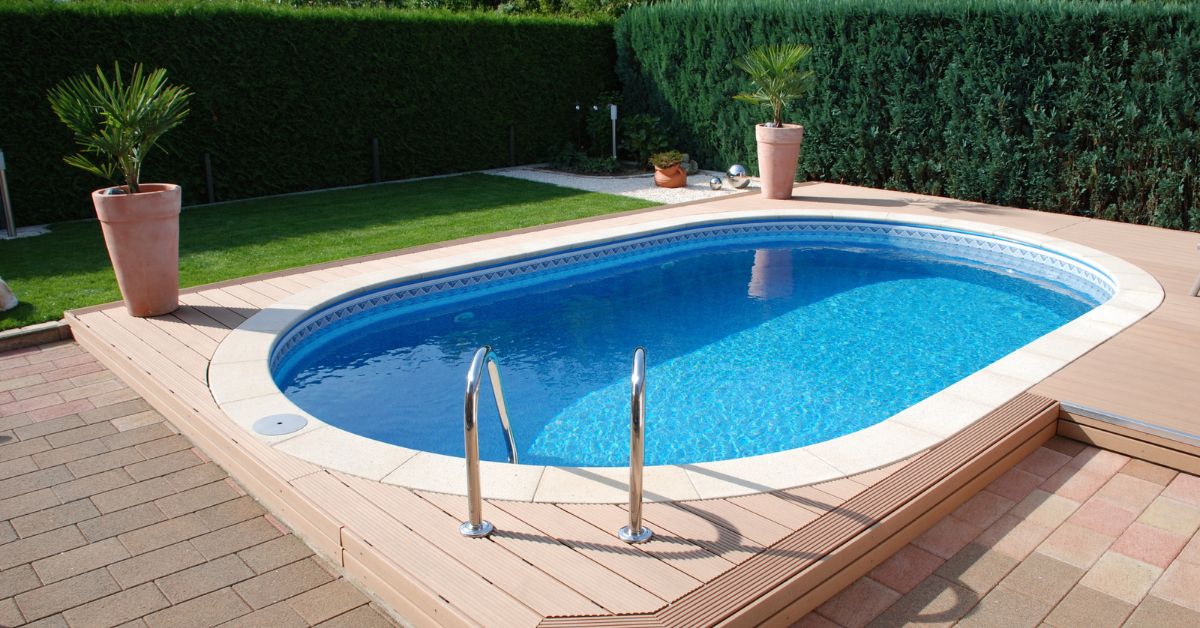When it involves outdoor amusement, above-floor pools are successful. But a few folks marvel: Can you put an above ground pool in the ground? It’s a legitimate query. People need to maximize their area even as they keep things safe. In this blog, we are going to interrupt it.
We’ll talk approximately what you need to remember, the great things, and the things to look out for while shopping for an above-floor pool. Let’s dive in!
This discrepancy has led a few pool owners to explore the opportunity of burying their above-ground swimming pools, including partly or sinking the pool into the floor. The concept is appealing—by mixing the pool with the encompassing panorama, owners can obtain a more cohesive and visually appealing outdoor environment.
But under the attraction of this idea lie important considerations and capability challenges that must be cautiously addressed to ensure the venture’s protection and fulfillment.
In this complete guide, we will explore the intricacies of burying, providing you with the expertise and insights needed to make informed choices at each step.
Above Ground Pools Built in Ground
Creating an above-floor pool built into the ground is a multi-step process that requires cautious planning, excavation, reinforcement, and finishing touches. Here’s an in-depth evaluation of the typical steps worried:
Assessment and Planning
Thorough assessment and meticulous planning are important before above ground pools installed inground built into the floor. Begin by surveying the location where you propose to install the pool.
Take note of the soil type, drainage patterns, accessibility for production equipment, and proximity to utilities, including water and energy. These elements will affect the feasibility and logistics of the task.
Next, don’t forget the size and shape of the pool that high-quality suits your space and meets your desires. Measure the to-be-had area cautiously, keeping in mind any landscaping capabilities or systems that could impact the pool’s placement.
Additionally, consult local construction codes and guidelines to ensure compliance with any necessities for pool installation, protection, and zoning regulations. Understanding and adhering to those guidelines from the outset will help prevent delays and ability troubles down the line.
Excavation
Once the planning phase is complete, it’s time to prepare the site for the installation of the pool. This is a significant step as it sets the foundation for the pool.
By marking the edge of the pool location and ensuring its accurate placement, you can feel the significance of this step in the overall heat above ground pool installation.
With the fringe marked, continue to excavate the location internal the usage of appropriate digging gadget. The intensity of the excavation will rely on the dimensions and form of the pool, as well as any extra functions along with decking or retaining partitions. Remove any rocks, roots, or debris from the excavation website online to create a easy and stage floor for the pool set up.
Preparation of Base
With the excavation complete, it is time to prepare the bottom for the pool. Start by evenly spreading a layer of sand or gravel across the pit’s bottom. This base layer will offer stability and support for the pool partitions while also helping to save you from shifting or settling over time.
Use a tamper or curler to compact the base fabric very well, making sure a firm foundation for the pool partitions to rest upon.
Pay close attention to areas where the soil may be softer or more susceptible to settling and take greater care to compact those areas properly. A properly organized base is crucial for the structural integrity and toughness of the pool installation.
Installation of Pool Walls
With the bottom prepared, gathering and deploying the pool partitions is time. Follow the producer’s instructions carefully, ensuring that every panel is hooked up securely and aligned well. Assemble the partitions within the excavated pit, checking for degree and alignment as you cross.
Once the walls are in the vicinity, use braces or other supports to stabilize them and prevent transferring during the installation method.
This step is specifically crucial for larger or deeper pools in which the water can exert a good amount of pressure on the partitions. Take it slow to make sure that the walls are well-supported and secured before proceeding to the next step.
Backfilling and Reinforcement
After the pool walls are securely in place, it is time to backfill the area around the outside of the walls. Gradually fill inside the space with soil or gravel, constructing layers and compacting them to provide support.
Make sure that the close above ground pool doesn’t have any voids or gaps across the walls and fill them in as needed to prevent settling or shifting.
In addition to backfilling, recall installing extra reinforcements inclusive of keeping partitions, braces, or decking around the perimeter of the pool.
These functions can assist in enhancing stability, preventing soil erosion, and creating a completed search for the pool region. Take into consideration any drainage concerns and deploy appropriate capabilities together with French drains or gravel trenches to divert water away from the pool and save you from flooding.
Finishing Touches
Once the pool partitions are steady and the surrounding area is backfilled and bolstered, it is time to add the finishing touches.
Install decking, landscaping, or fencing around the pool to decorate protection, accessibility, and aesthetics. Choose materials and features that complement the overall layout of your outdoor area and create a cohesive appearance.
Before filling the pool with water, check the filtration and stream structures to ensure proper functionality. Check for any leaks or troubles that could need to be addressed earlier than finalizing the set up. Once everything is in working order, fill the pool with water and revel in the end result of your exertions.
Safety Measures
Last but not least, don’t forget to put in force protection measures to protect yourself, your loved ones, and others who might also use the pool. Install safety features, including pool covers, fences, or alarms, to save you from injuries and unauthorized entry.
Educate yourself and others about pool safety practices, inclusive of the right supervision of kids and adherence to protection hints. By taking these precautions, you could make certain that your above ground pools built in ground presents years of enjoyment in secure and stable surroundings.
Risks and Benefits Of Installing Above Ground Pool
| Risks | Benefits |
| Limited long-term durability | Lower initial cost compared to in-ground pools |
| Potential for structural issues | Quick and easy installation process |
| Limited customization options | Easy relocation or removal if necessary |
| Lower resale value compared to in-ground pools | Versatile design options for various spaces |
| Not suitable for all landscapes | Reduced maintenance and upkeep requirements |
This table gives a clear evaluation of the ability risks and blessings related to above ground pool in ground set up, assisting homeowners in making well-knowledgeable selections tailored to their choices and instances.
Above Ground Pool Partially in Ground
It is not recommended to completely bury an above-floor pool in the ground, as the pool walls are not designed to resist the inward stress from the encompassing soil. This can cause the partitions to collapse, making swimmers prone to injury.
However, it is feasible to, in part, bury an above-floor pool, commonly up to around 2 ft deep, without voiding the manufacturer’s assurance. This can assist the pool combo in higher with the panorama, especially on sloped or uneven terrain.
The key is to follow the manufacturer’s specific instructions at the most advocated depth for partial burial. Exceeding this depth can cause damage to the pool partitions, skimmers, and filters.
An opportunity option is to install a semi-above-ground pool that is partly or fully submerged in the floor.
These swimming pools have more potent, greater durable partitions that can withstand soil pressure, and they regularly include a longer warranty.
However, partially burying an above-ground pool is possible. Still, it requires careful attention to the manufacturer’s hints and may need to be more secure and durable than a purpose-built semi-above-floor or in-floor pool.
Cost Of Above Ground Pool in Ground
The fee of installing an above-floor pool in the floor can vary depending on factors, including the kind of pool, size, installation charges, and any extra functions or add-ons.
According to our research on the fee of putting an above ground pool in the ground:
The common cost of an above-ground pool can range from $1,500 to $7,500 for the pool itself, with extra charges for a professional setup.
Installation fees for an above-ground pool can range from $1,000 to $3,000, depending on the type and length of the pool.
Semi-inground pools, which offer a mix of in-floor and above-ground advantages, can fee between $6,000 and $12,000.
Furthermore, the fee for installing an above-ground pool on the floor can vary appreciably based on the type of pool, installation method, and additional charges. Semi-inground pools are commonly a more pricey choice due to their included design and adaptability to uneven terrain.
Can You Install Above Ground Pool Inground
Yes, it is possible to install above ground pool partially in ground or completely inground, even though it requires careful planning, proper training, and adherence to safety pointers.
This procedure includes sinking the pool into the ground to create a more integrated and aesthetically appealing look while maintaining the structural integrity and protection of the pool.
Final Advice
The selection to partially or fully sink an above-floor pool includes careful planning, proper guidance, and adherence to safety recommendations.
By assessing factors such as soil type, drainage, structural integrity, and compliance with neighborhood rules, homeowners can mitigate capacity risks and create a secure and exciting swimming environment.
It’s important to apprehend that above ground pool cleaning can affect its structural integrity and durability if not executed correctly.
Potential troubles, which include soil moving, drainage problems, and insufficient support, can compromise the stability and safety of the pool over time. Therefore, consulting with specialists, obtaining necessary lets in, and following producer guidelines are important steps in ensuring the protection and fulfillment of the setup.
Despite the challenges, there are awesome advantages to setting up an above-ground pool within the ground, such as improved aesthetics, increased privacy, and higher integration with the encircling panorama.
With cautious planning, proper installation, and ongoing preservation, homeowners can create a beautiful and functional outdoor oasis that provides years of secure enjoyment for themselves and their households.
Ultimately, the protection of an above ground pools installed inground relies upon thoughtful attention, meticulous execution, and a dedication to ensuring a steady and exciting swimming revel.






